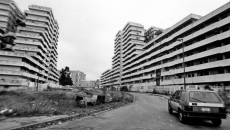
Email: emanuelealbertocirello.98@gmail.com
Total Article : 76
About Me:I am a Year 13 student which aspires to be an architect. I am interested in anything I don't yet know, and I mostly write about art, politics , Italian culture and inspirational people, although I will try to write for as many categories possible, just to test myself and get to know more things.

Scampia’s “Le Vele” (“The Sails”), built between the early 60’s and mid 70’s, embodied the concept of “residential machine”; they consist of megastructures where individual spaces were part of a vast system of communal and shared areas, showing some type of social experimentation popular in the previous century. The architect Francesco Di Salvo, which made his fortune by building in the urban areas surrounding Naples, was called to build this utopian housing complex by erecting seven huge buildings in Naples northern suburbs, precisely in Scampia. His work was inspired by the success achieved by Le Corbusier with the construction of “l’Unité d’Habitation” in Marseille in 1952, which also provided a model for the making of the Olympic Park in Montreal during 1976, which provided a luxurious housing complex well connected with the urban structure of the city.
However, the success of such projects on international scale did not reveal to have the same success in Italy. Before the realisation of “Le Vele” in Scampia, the “Zen district” in Palermo, “il Corviale” in Rome and the “Rozzol Melara” in Trieste are examples of how large scale housing complex did not work out as desired, as the social housing shortly became synonym of social degradation.
To the scarce identification and sense of belonging of the inhabitants of these housing complexes, which did not have a humane dimension within them, many poor political administrations added a lack of services and connections in terms of public transport to the city centre, making the conditions of these areas even worse due to isolation.
“Le Vele” revealed to be such a negative project that, in 1997, the city’s mayor Bassolino decided to demolish three of the seven buildings. 258 tonnes of dynamite were needed to pulverise the structure and although the original plan was to extirpate the root of this failed and degrading utopia, this move from the city administration revealed to be a failure as well. The housing complex built to replace them were even more chaotic and without any logic planning and terribly failed to change the pre-existing squalor in Scampia. To this day, the residents live in hardship, in a place where criminality has taken over and still suffocates any sort of regeneration and change.

The architect Ada Tolla, which is a teacher at the Columbia University in NYC has said that “the demolition is a way to hide the dirt under the dust without learning from the past”, and she was right as the following unsuccessful schemes showed. The project was meant to include shared recreational areas but it was radically modified during the making. Due to seismic risk, the structural section have had to increase significantly in number and size, with a reduction of empty spaces making those recreational areas dark and uninviting. The lack of control and management and a project that was not made according to the proposed plans have made “Le Vele” are symbol of failure to which a solution has not been found yet.
The current mayor De Magistris, who promised a €18 million investment for Scampia during his campaign, has recently expressed the will of demolishing a further three of the buildings, and make of the fourth one a centre for services by inviting architects and designers from all over the globe. Last month, on November 10th, 115 families have been relocated to the new apartments built on the land where the old mega-structures were located. This may be seen as a start for change, but again it could lead to the neglect of surrounding areas and lead to mistakes that have been previously made. Despite the presence of some changes made recently, the present condition of “Le Vele” is still far from the utopian vision that the architect Di Salvo had in the 60’s while designing it. The area needs a massive effort from the local, regional and national government, and luckily there are some ideas for what the future of “Le Vele” could be.
Image credits: http://th.designerblog.it/47W3_fi8MiPyRqz21R1GTDYLxiE=/fit-in/655xorig/http://media.designerblog.it/8/8eb/a4bce5a9132205017ee5086aa1e4a668-620x350.jpg
http://2.citynews-today.stgy.ovh/~media/original-hi/18447349425526/vele-scampia-2.jpg

0 Comment:
Be the first one to comment on this article.